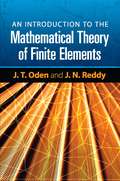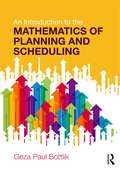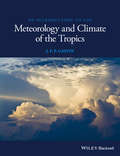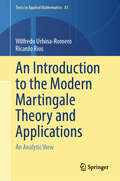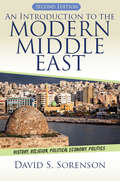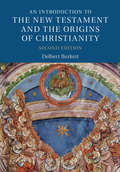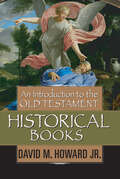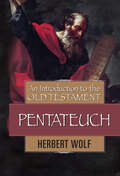- Table View
- List View
An Introduction to the Mathematical Theory of Dynamic Materials (Advances in Mechanics and Mathematics #15)
by Konstantin A. LurieThis fascinating book is a treatise on real space-age materials. It is a mathematical treatment of a novel concept in material science that characterizes the properties of dynamic materials--that is, material substances whose properties are variable in space and time. Unlike conventional composites that are often found in nature, dynamic materials are mostly the products of modern technology developed to maintain the most effective control over dynamic processes.
An Introduction to the Mathematical Theory of Finite Elements (Dover Books on Engineering)
by J. N. Reddy J. T. OdenThis introduction to the theory of Sobolev spaces and Hilbert space methods in partial differential equations is geared toward readers of modest mathematical backgrounds. It offers coherent, accessible demonstrations of the use of these techniques in developing the foundations of the theory of finite element approximations.J. T. Oden is Director of the Institute for Computational Engineering & Sciences (ICES) at the University of Texas at Austin, and J. N. Reddy is a Professor of Engineering at Texas A&M University. They developed this essentially self-contained text from their seminars and courses for students with diverse educational backgrounds. Their effective presentation begins with introductory accounts of the theory of distributions, Sobolev spaces, intermediate spaces and duality, the theory of elliptic equations, and variational boundary value problems. The second half of the text explores the theory of finite element interpolation, finite element methods for elliptic equations, and finite element methods for initial boundary value problems. Detailed proofs of the major theorems appear throughout the text, in addition to numerous examples.
An Introduction to the Mathematical Theory of Inverse Problems (Applied Mathematical Sciences #120)
by Andreas KirschThis book introduces the reader to the area of inverse problems. The study of inverse problems is of vital interest to many areas of science and technology such as geophysical exploration, system identification, nondestructive testing and ultrasonic tomography. The aim of this book is twofold: in the first part, the reader is exposed to the basic notions and difficulties encountered with ill-posed problems. Basic properties of regularization methods for linear ill-posed problems are studied by means of several simple analytical and numerical examples. The second part of the book presents two special nonlinear inverse problems in detail - the inverse spectral problem and the inverse scattering problem. The corresponding direct problems are studied with respect to existence, uniqueness and continuous dependence on parameters. Then some theoretical results as well as numerical procedures for the inverse problems are discussed. The choice of material and its presentation in the book are new, thus making it particularly suitable for graduate students. Basic knowledge of real analysis is assumed. In this new edition, the Factorization Method is included as one of the prominent members in this monograph. Since the Factorization Method is particularly simple for the problem of EIT and this field has attracted a lot of attention during the past decade a chapter on EIT has been added in this monograph as Chapter 5 while the chapter on inverse scattering theory is now Chapter 6.The main changes of this second edition compared to the first edition concern only Chapters 5 and 6 and the Appendix A. Chapter 5 introduces the reader to the inverse problem of electrical impedance tomography.
An Introduction to the Mathematical Theory of Inverse Problems (Applied Mathematical Sciences #120)
by Andreas KirschThis graduate-level textbook introduces the reader to the area of inverse problems, vital to many fields including geophysical exploration, system identification, nondestructive testing, and ultrasonic tomography. It aims to expose the basic notions and difficulties encountered with ill-posed problems, analyzing basic properties of regularization methods for ill-posed problems via several simple analytical and numerical examples. The book also presents three special nonlinear inverse problems in detail: the inverse spectral problem, the inverse problem of electrical impedance tomography (EIT), and the inverse scattering problem. The corresponding direct problems are studied with respect to existence, uniqueness, and continuous dependence on parameters. Ultimately, the text discusses theoretical results as well as numerical procedures for the inverse problems, including many exercises and illustrations to complement coursework in mathematics and engineering. This updated text includes a new chapter on the theory of nonlinear inverse problems in response to the field’s growing popularity, as well as a new section on the interior transmission eigenvalue problem which complements the Sturm-Liouville problem and which has received great attention since the previous edition was published.
An Introduction to the Mathematics of Planning and Scheduling
by Geza Paul BottlikThis book introduces readers to the many variables and constraints involved in planning and scheduling complex systems, such as airline flights and university courses. Students will become acquainted with the necessity for scheduling activities under conditions of limited resources in industrial and service environments, and become familiar with methods of problem solving. Written by an expert author with decades of teaching and industry experience, the book provides a comprehensive explanation of the mathematical foundations to solving complex requirements, helping students to understand underlying models, to navigate software applications more easily, and to apply sophisticated solutions to project management. This is emphasized by real-world examples, which follow the components of the manufacturing process from inventory to production to delivery. Undergraduate and graduate students of industrial engineering, systems engineering, and operations management will find this book useful in understanding optimization with respect to planning and scheduling.
An Introduction to the Mechanics of Incompressible Fluids
by Michel O. DevilleThis open access book allows the reader to grasp the main bulk of fluid flow problems at a brisk pace. Starting with the basic concepts of conservation laws developed using continuum mechanics, the incompressibility of a fluid is explained and modeled, leading to the famous Navier-Stokes equation that governs the dynamics of fluids. Some exact solutions for transient and steady-state cases in Cartesian and axisymmetric coordinates are proposed. A particular set of examples is associated with creeping or Stokes flows, where viscosity is the dominant physical phenomenon. Irrotational flows are treated by introducing complex variables. The use of the conformal mapping and the Joukowski transformation allows the treatment of the flow around an airfoil. The boundary layer theory corrects the earlier approach with the Prandtl equations, their solution for the case of a flat plate, and the von Karman integral equation. The instability of fluid flows is studied for parallel flows using the Orr-Sommerfeld equation. The stability of a circular Couette flow is also described. The book ends with the modeling of turbulence by the Reynolds-averaged Navier-Stokes equations and large-eddy simulations. Each chapter includes useful practice problems and their solutions. The book is useful for engineers, physicists, and scientists interested in the fascinating field of fluid mechanics.
An Introduction to the Medieval Bible
by Frans Van LiereThe Middle Ages spanned the period between two watersheds in the history of the biblical text: Jerome's Latin translation c. 405 and Gutenberg's first printed version in 1455. The Bible was arguably the most influential book during this time, affecting spiritual and intellectual life, popular devotion, theology, political structures, art, and architecture. In an account that is sensitive to the religiously diverse world of the Middle Ages, Frans van Liere offers here an accessible introduction to the study of the Bible in this period. Discussion of the material evidence - the Bible as book - complements an in-depth examination of concepts such as lay literacy and book culture. This introduction includes a thorough treatment of the principles of medieval hermeneutics, and a discussion of the formation of the Latin bible text and its canon. It will be a useful starting point for all those engaged in medieval and biblical studies.
An Introduction to the Meteorology and Climate of the Tropics
by J. F. GalvinWhat do we mean by the tropics? The weather and the climates it produces across the tropical zone are significantly different from those experienced by the people living in higher latitudes, so forecasters across Europe and much of North America are unfamiliar with its effects. In this book, Jim Galvin demystifies the topic in this zone that is increasingly of interest to those studying weather and climate. This book was written for weather forecasters, meteorology, environmental science and geography students as an introductory guide. It builds on the experience of the author, his professional experience in the World Area Forecast Centre at the Met Office, Exeter, using studies into the weather and climate seen within the tropical air mass conducted over many years. Its unique approach presents a practical approach to tropical weather studies, drawing on both academic and practical knowledge, covering air mass dynamics, seasonal changes, moist and dry weather, climate variability and human health in chapters and appendices that build up the overall picture, summarising our current state of knowledge. As an overview, it covers the broad range of effects connected with climate and weather in a straightforward way and is clearly illustrated throughout.
An Introduction to the Modern Martingale Theory and Applications: An Analytic View (Texts in Applied Mathematics #81)
by Wilfredo Urbina-Romero Ricardo RiosMartingale theory is a cornerstone of modern probability, offering a natural extension of the study of sums of independent random variables. Although its roots can be traced back to the work of Paul Lévy in 1937, it was Joseph L. Doob in the 1940s who formally developed the theory, culminating in his landmark book Stochastic Processes in 1953. Since then, martingale theory has evolved significantly, with deep contributions from mathematicians such as Donald L. Burkholder, Richard Gundy, and Burgess Davis, among others. This is what is now known as advanced martingale theory, which began with the publication of Burkholder&’s seminal paper Martingale Transforms in 1966. This book provides a comprehensive treatment of both classical and advanced martingale theory. It opens with a historical introduction, exploring foundational functions such as Rademacher, Haar, and Walsh functions, before delving into the core concepts of conditional probability. The classical theory, as developed by Doob, is meticulously presented, followed by an in-depth examination of modern advancements, including Burkholder&’s inequalities, Burkholder-Davis-Gundy inequality, and their generalizations, as well as good-lambda inequalities. The final chapter showcases a wide range of applications, highlighting the theory&’s profound impact on Banach space theory, harmonic analysis, and beyond. Intended for graduate students and researchers in probability and analysis, this book serves as both an introduction and a reference, offering a clear and structured approach to a subject that continues to shape mathematical research and its applications.
An Introduction to the Modern Middle East
by David S. SorensonCombining elements of comparative politics with a country-by-country analysis, author David S. Sorenson provides a complete and accessible introduction to the modern Middle East. With an emphasis on the politics of the region, the text also dedicates chapters specifically to the history, religions, and economies of countries in the Persian (Arabian) Gulf, the Eastern Mediterranean, and North Africa. In each country chapter, a brief political history is followed by discussions of democratization, religious politics, women's issues, civil society, economic development, privatization, and foreign relations. In this updated and revised second edition, An Introduction to the Modern Middle East includes new material on the Arab Spring, the changes in Turkish politics, the Iranian nuclear issues, and the latest efforts to resolve the Israeli-Palestinian dilemma. Introductory chapters provide an important thematic overview for each of the book's individual country chapters and short vignettes throughout the book offer readers a chance for personal reflection.
An Introduction to the Modern Middle East
by David S. SorensonCombining elements of comparative politics with a country-by-country analysis, author David S. Sorenson provides a complete and accessible introduction to the modern Middle East. With an emphasis on the politics of the region, the text also dedicates chapters specifically to the history, religions, and economies of countries in the Persian (Arabian) Gulf, the Eastern Mediterranean, and North Africa. In each country chapter, a brief political history is followed by discussions of democratization, religious politics, women's issues, civil society, economic development, privatization, and foreign relations. In this updated and revised second edition, An Introduction to the Modern Middle East includes new material on the Arab Spring, the changes in Turkish politics, the Iranian nuclear issues, and the latest efforts to resolve the Israeli-Palestinian dilemma. Introductory chapters provide an important thematic overview for each of the book's individual country chapters and short vignettes throughout the book offer readers a chance for personal reflection.
An Introduction to the Modern Middle East, Student Economy Edition: History, Religion, Political Economy, Politics
by David SorensonAn overview of the history, religion, political economy, and politics of the Middle East, with individual chapters devoted to each of the countries in the Persian (Arabian) Gulf, Eastern Mediterranean, and North Africa.
An Introduction to the Modern Middle East: History, Religion, Political Economy, Politics
by David S. SorensonCombining elements of comparative politics with a country-by-country analysis, author David S. Sorenson provides a complete and accessible introduction to the modern Middle East. With an emphasis on the politics of the region, the text also dedicates chapters specifically to the history, religions, and economies of countries in the Persian (Arabian) Gulf, the Eastern Mediterranean, and North Africa. In each country chapter, a brief political history is followed by discussions of democratization, religious politics, women's issues, civil society, economic development, privatization, and foreign relations.In this updated and revised second edition, An Introduction to the Modern Middle East includes new material on the Arab Spring, the changes in Turkish politics, the Iranian nuclear issues, and the latest efforts to resolve the Israeli-Palestinian dilemma. Introductory chapters provide an important thematic overview for each of the book's individual country chapters and short vignettes throughout the book offer readers a chance for personal reflection.
An Introduction to the New Testament
by Raymond E. BrownFrom the experience of a lifetime of scholarship, preaching, teaching, and writing, Raymond E. Brown covers the entire scope of the New Testament with ease and clarity. He walks readers book by book through the basic content and issues of the New Testament. While a wealth of information is contained in these pages, the work's most impressive features are the basic summaries of each book, a historical overview of the ancient Greco-Roman world, discussions of key theological issues, and the rich supplementary materials, such as illustrative tables, maps, bibliographies, and appendixes. Using this basic data, Brown answers questions raised by today's readers, relates the New Testament to our modern world, and responds to controversial issues, such as those raised by the Jesus Seminar. Every generation needs a comprehensive, reliable Introduction to the New Testament that opens the biblical text to the novice. Raymond E. Brown's An Introduction to the New Testament is the most trustworthy and authoritative guidebook for a generation seeking to understand the Christian Bible. Universally acknowledged as the dean of New Testament scholarship, Father Brown is a master of his discipline at the pinnacle of his career. Who else could cover the entire scope of the New Testament with such ease and clarity? This gifted communicator conveys the heartfelt concern of a beloved teacher for his students, as he walks the reader through the basic content and issues of the New Testament. Those opening to the New Testament for the first time and those seeking deeper insights could not ask for more in a primer to the Christian Bible.
An Introduction to the New Testament and the Origins of Christianity
by Delbert BurkettThis book offers an authoritative and accessible introduction to the New Testament and early Christian literature for all students of the Bible and anyone interested in the origins of Christianity. It is designed primarily for undergraduate courses in the New Testament, biblical studies and early Christianity. There are questions for in-class discussion and written assignment, step-by-step reading guides on individual works, special box features, charts, maps and numerous illustrations designed to facilitate student use. With this textbook and the Bible, the student should therefore have all the necessary basic texts.
An Introduction to the New Testament and the Origins of Christianity (Introduction to Religion)
by Delbert BurkettFirst published in 2002, this book offers an authoritative and accessible introduction to the New Testament and early Christian literature for all students of the Bible and the origins of Christianity. Delbert Burkett focuses on the New Testament, but also looks at a wealth of non-biblical writing to examine the history, religion and literature of Christianity in the years from 30 CE to 150 CE. The book is organized systematically with questions for in-class discussion and written assignments, step-by-step reading guides on individual works, special box features, charts, maps and numerous illustrations designed to facilitate student use. An appendix containing translations of primary texts allows instant access to the writings outside the canon. For this new edition, Burkett has reorganized and rewritten many chapters, and has also incorporated revisions throughout the text, bringing it up to date with current scholarship. This volume is designed for use as the primary textbook for one and two-semester courses on the New Testament and Early Christianity.
An Introduction to the New Testament: Contexts, Methods and Ministry Formation
by David A DeSilvaThis New Testament introduction is different. Many introductions zero in on the historical contexts in which the New Testament literature was written. This introduction goes further--to give particular attention to the social, cultural, and rhetorical contexts of the New Testament authors and their writings. <p><p> Few introductions to the New Testament integrate instruction in exegetical and interpretive strategies with the customary considerations of authorship, dating, audience, and message. This introduction capitalizes on the opportunity, introducing students to a relevant facet of interpretation with each portion of New Testament literature. Rarely do introductions to the New Testament approach their task mindful of students preparing for ministry. This introduction is explicit in doing so, recognizing as it does that the New Testament itself--in its parts and as a whole--is a pastoral resource. <p><p> Each chapter on the New Testament literature closes with a discussion of implications for ministry formation. These integrative features alone would distinguish this introduction from others. But in addition, its pages brim with maps, photos, points of interest, and aids to learning. Separate chapters explore the historical and cultural environment of the New Testament era, the nature of the Gospels and the quest for the historical Jesus, and the life of Paul. First published in 2004, David A. deSilva's comprehensive and carefully crafted introduction to the New Testament has been long established as an authoritative textbook and resource for students.
An Introduction to the New Testament: History, Literature, Theology
by M. Eugene BoringThis thoroughly researched textbook from well-respected scholar M. Eugene Boring presents a user-friendly introduction to the New Testament books. Boring approaches the New Testament as a historical document, one that requires using a hands-on, critical method. Moreover, he asserts that the New Testament is the church's book, in that it was written, selected, preserved, and transmitted by the church. Boring goes on to explore the historical foundation and formation of the New Testament within the context of pre-Christian Judaism and the world of Jesus and the early church. He then examines the individual books of the New Testament, providing helpful background information and methods for interpretation, and revealing the narrative substructure found within each of the Gospels and Letters. This volume includes helpful illustrations, charts, notes, and suggestions for further reading. Sections are laid out in a well-organized manner to help students navigate the content more easily.
An Introduction to the New Testament: History, Literature, Theology
by M. Eugene BoringThis thoroughly researched textbook from well-respected scholar M. Eugene Boring presents a user-friendly introduction to the New Testament books. Boring approaches the New Testament as a historical document, one that requires using a hands-on, critical method. Moreover, he asserts that the New Testament is the church's book, in that it was written, selected, preserved, and transmitted by the church. Boring goes on to explore the historical foundation and formation of the New Testament within the context of pre-Christian Judaism and the world of Jesus and the early church. He then examines the individual books of the New Testament, providing helpful background information and methods for interpretation, and revealing the narrative substructure found within each of the Gospels and Letters. This volume includes helpful illustrations, charts, notes, and suggestions for further reading. Sections are laid out in a well-organized manner to help students navigate the content more easily.
An Introduction to the New Testament: The Abridged Edition
by Raymond E. Brown Marion SoardsSince its publication in 1997, Raymond Brown's Introduction to the New Testament has been widely embraced by modern readers seeking to understand the Christian Bible. Acknowledged as a paragon of New Testament studies in his lifetime, Brown was a gifted communicator who wrote with ease and clarity.  Abridged by Marion Soards, who worked with Brown on the original text, this new, concise version maintains the essence and centrist interpretation of the original without tampering with Brown's perspective, insights, or conclusions. The biblical writings themselves remain the focus, but there are also chapters dealing with the nature, origin, and interpretation of the New Testament texts, as well as chapters concerning the political, social, religious, and philosophical world of antiquity. Furthermore, augmenting Brown's commentary on the New Testament itself are topics such as the Gospels' relationship to one another; the form and function of ancient letters; Paul's thought and life, along with his motivation, legacy, and theology; a reflection on the historical Jesus; and a survey of relevant Jewish and Christian writings.  This comprehensive, reliable, and authoritative guidebook is now more accessible for novices, general readers, Bible study groups, ministers, scholars, and students alike.
An Introduction to the Old Testament Historical Books
by David M. HowardRich rewards await readers who dig deep into the historical books of the Old Testament. Incredible events, amazing love stories, larger-than-life personalities, and deep theological themes are just some of the treasures found in Joshua, Judges, Ruth, 1 and 2 Samuel, 1 and 2 Kings, 1 and 2 Chronicles, Ezra, Nehemiah, Esther. <p><p> These books tell the story of the nation of Israel and the God who loves her, punishes her, and always brings this recalcitrant people back to Himself. It is really the story of all of us. <p><p> David M. Howard Jr. provides an in-depth introduction to the Old Testament historical books, focusing first on the overarching themes of historical narrative in general. He then turns his attention to each book, considering topics like: <p>• Authorship and date <p>• Place in the canon <p>• Historical and cultural context <p>• Theology of the book <p>• Special issues pertaining to the book <p><p> From the conquest of Canaan to the fall of Jerusalem, from war to peace and back to war, from kings and queens to farmers and housewives—David Howard covers it all in this invaluable introduction to the Old Testament historical books.
An Introduction to the Old Testament Historical Books
by David M. Howard Jr.Rich rewards await readers who dig deep into the historical books of the Old Testament. Incredible events, amazing love stories, larger-than-life personalities and deep theological implications and themes are just part of the t treasure that awaits readers of Joshua, Judges, Ruth, 1 & 2 Samuel, 1 & 2 Kings, 1 & 2 Chronicles, Ezra, Nehemiah, Esther.These books tell the story of the nation of Israel and the God who loves her, punishes her, and always brings this recalcitrant people back to Himself. It is really the story of all of us.David M. Howard Jr. provides an in-depth introduction to the Old Testament historical books, focusing first on the overarching themes of historical narrative in general. He then turns his attention to each book.From the conquest of Canaan to the fall of Jerusalem, from war to peace and back to war, from kings and queens to farmers and housewives--David Howard covers it all in this invaluable introduction to the Old Testament historical books.
An Introduction to the Old Testament Historical Books
by David M. Howard Jr.Rich rewards await readers who dig deep into the historical books of the Old Testament. Incredible events, amazing love stories, larger-than-life personalities and deep theological implications and themes are just part of the t treasure that awaits readers of Joshua, Judges, Ruth, 1 & 2 Samuel, 1 & 2 Kings, 1 & 2 Chronicles, Ezra, Nehemiah, Esther.These books tell the story of the nation of Israel and the God who loves her, punishes her, and always brings this recalcitrant people back to Himself. It is really the story of all of us.David M. Howard Jr. provides an in-depth introduction to the Old Testament historical books, focusing first on the overarching themes of historical narrative in general. He then turns his attention to each book.From the conquest of Canaan to the fall of Jerusalem, from war to peace and back to war, from kings and queens to farmers and housewives--David Howard covers it all in this invaluable introduction to the Old Testament historical books.
An Introduction to the Old Testament Pentateuch
by Herbert WolfThe Pentateuch--Genesis, Exodus, Leviticus, Numbers, Deuteronomy--are the vital first books in the Bible. understanding the scope, meaning, and events of these five books is integral to understanding the whole of Scripture that follows.Old Testament expert Herbert Wolf provides layreaders and scholars alike with a strong undergirding of understanding and knowledge in this introduction that reveals both the seriousness and excitement of the Pentateuch. Readers will find Adam, Abraham, Joseph, Moses and Joshua in these pages, as well as terrible sin and glorious forgiveness, bloody sacrifices and battles, deadly betrayal and life-giving hope.Wolf first addresses the overarching themes that flow through the Pentateuch, with special attention given to Moses as author of the five books. He then addresses each book specifically, covering topics such as purpose and scope, and literary structure. He tailors additional study to each specific book. This book contributes significantly to a clear, deep understanding of the Bible's first five books.
An Introduction to the Old Testament Pentateuch
by Herbert WolfThe Pentateuch--Genesis, Exodus, Leviticus, Numbers, Deuteronomy--are the vital first books in the Bible. understanding the scope, meaning, and events of these five books is integral to understanding the whole of Scripture that follows.Old Testament expert Herbert Wolf provides layreaders and scholars alike with a strong undergirding of understanding and knowledge in this introduction that reveals both the seriousness and excitement of the Pentateuch. Readers will find Adam, Abraham, Joseph, Moses and Joshua in these pages, as well as terrible sin and glorious forgiveness, bloody sacrifices and battles, deadly betrayal and life-giving hope.Wolf first addresses the overarching themes that flow through the Pentateuch, with special attention given to Moses as author of the five books. He then addresses each book specifically, covering topics such as purpose and scope, and literary structure. He tailors additional study to each specific book. This book contributes significantly to a clear, deep understanding of the Bible's first five books.

